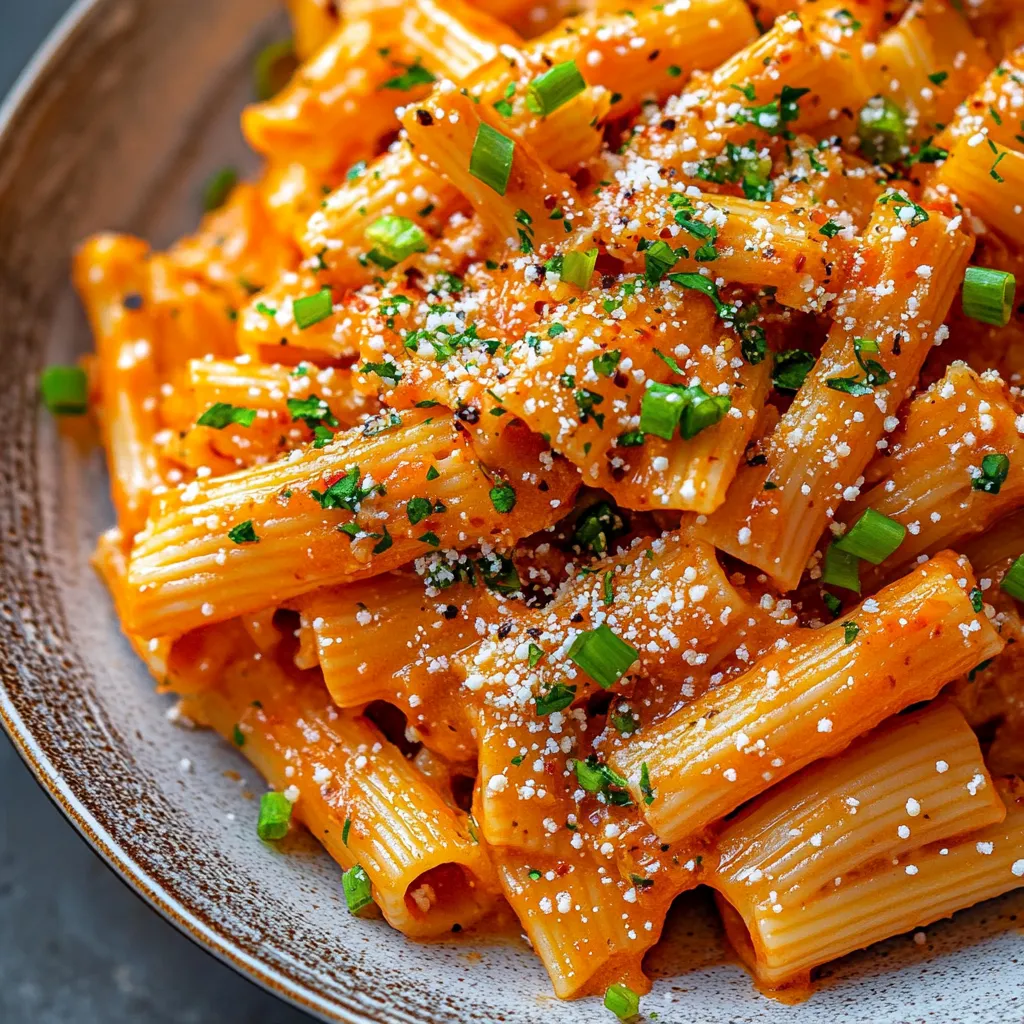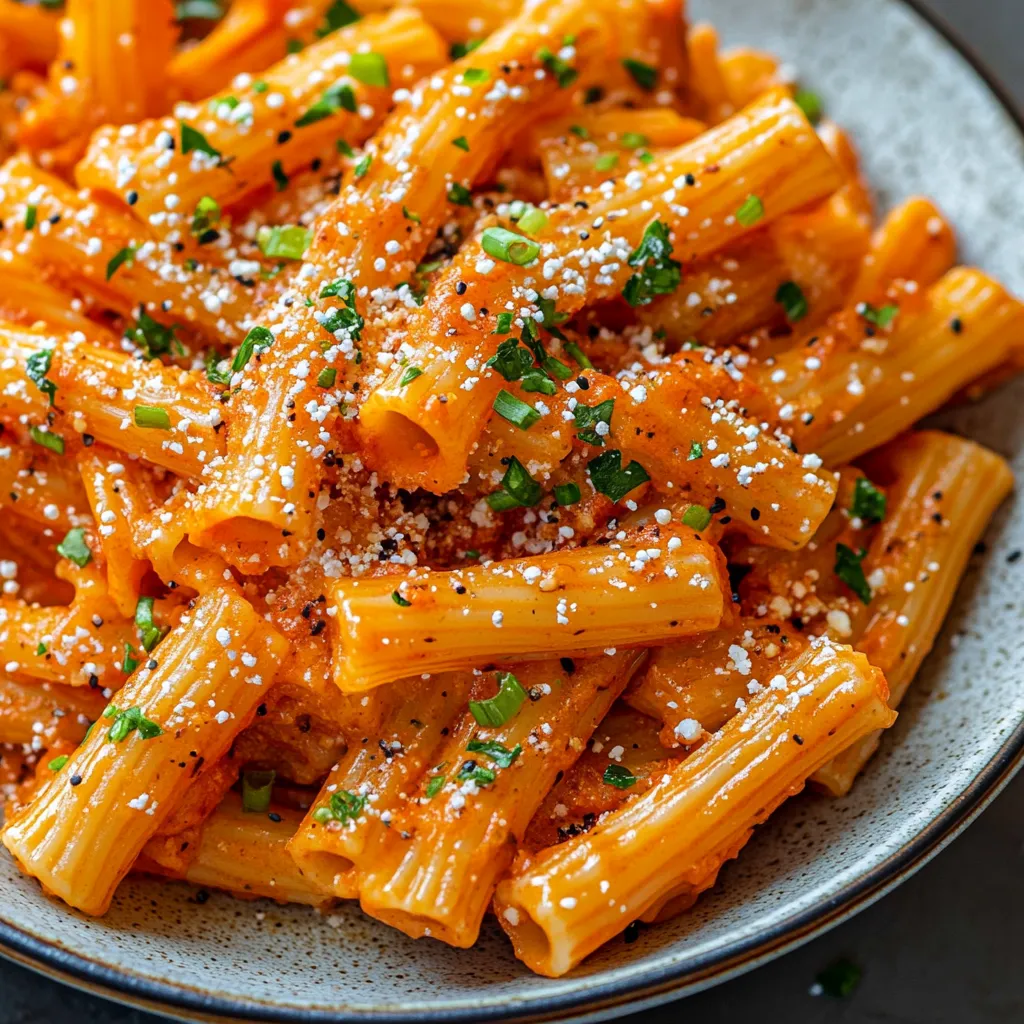 Save
Save
This gochujang pasta takes basic ingredients and turns them into a smooth, fiery treat that's now my favorite dish when I want something cozy with some heat. Mixing Korean gochujang with Italian pasta makes a surprising but really tasty combo that hits the spot when I'm looking for something both spicy and rich.
I came up with this dish during a freezing winter when I wanted something hot but was tired of making soup. These days it's the first thing my partner asks for when it gets cold outside, and all the friends I've shown it to have started making it regularly too.
What You'll Need
- Olive oil: Sets up the base for cooking the garlic and brings a light richness
- Garlic cloves: Fresh and chopped fine to give a tasty smell that goes through the whole dish
- Water or chicken stock: This is what the pasta cooks in and adds more taste
- Beef stock cube: Gives a deep, meaty flavor throughout the sauce
- Salt: Brings out all the tastes and makes sure the pasta isn't bland
- Rigatoni pasta: The grooves and hollow shape grab onto the sauce really well
- Gochujang paste: The main flavor that brings sweet, spicy, fermented goodness
- Full-fat cream cheese: Makes everything creamy and smooth without breaking down when hot
- Parmesan cheese: Adds a salty, nutty flavor and helps make the sauce thicker
- Dried parsley: Gives a bit of herb flavor to balance the rich sauce
- Spring onions: Add a fresh crunch and mild onion taste on top
- Chili flakes: You can add these if you want it even spicier
Cooking Instructions
- Start With Garlic:
- Warm olive oil in a big, deep skillet over low heat. Toss in chopped garlic and cook it slowly for 1-2 minutes until it smells good but isn't brown. Going slow lets the garlic flavor come out without getting bitter.
- Make Your Cooking Liquid:
- Add 4 cups of hot water or stock, throw in the beef cube and salt. Get it all boiling fast to make a tasty base for cooking the pasta.
- Add The Pasta:
- Drop the rigatoni right into the boiling mix. Let it cook about 5 minutes, giving it a stir now and then so it doesn't stick. The pasta will soak up all the good flavors as it cooks.
- Mix Up The Gochujang:
- Scoop about 1/4 cup of the hot pasta water into a small bowl. Mix in the gochujang paste until it's completely melted. This makes it blend into the dish smoothly without lumps.
- Mix Everything Together:
- When pasta is just tender and most liquid is gone, turn the heat way down. If there's too much water left, drain the pasta but keep 1/2 cup of the cooking water. Add your melted gochujang and mix until pasta is coated evenly.
- Make It Creamy:
- Add small chunks of cream cheese, stirring all the time until it melts into a smooth sauce. If it gets too thick, slowly add some of that saved pasta water until it looks right.
- Add Final Flavors:
- Turn off the heat and mix in Parmesan cheese and dried parsley until they're all blended in. Taste it and add black pepper if needed. The hot pasta will melt the cheese just right.
- Top It Off:
- Sprinkle sliced green parts of spring onions on top and chili flakes if you want extra heat. Serve it up right away with extra Parmesan cheese on the side for people to add.

When I first tried making this pasta, I wasn't sure about mixing gochujang with Italian stuff, but the deep flavor of the Korean chili paste works amazingly well with creamy cheese in ways I didn't expect. I love watching guests try to figure out what the secret ingredient is that makes this pasta so different from normal cream sauces.
Making It More Or Less Spicy
Different brands of gochujang can be milder or hotter, so start with less if you're not sure how spicy you like things. You can always put in more as you taste the sauce. Beginners should use 1 tablespoon instead of 2, while spice fans can go up to 3 tablespoons for more kick. Just know that the cream cheese really tones down the heat, so it won't be as fiery as the gochujang tastes by itself.
Keeping Leftovers
This pasta stays good in the fridge for up to 3 days if you keep it in a container with a tight lid. When you want to warm it up, add a little milk or water since the sauce gets pretty thick when cold. Heat it up slowly on medium-low, stirring often so it doesn't burn. The flavor actually gets better overnight, and many of my friends say they like the leftovers even more than when it's freshly made.
Things You Can Add
While it tastes great on its own, this pasta works well with extras that can make it a bigger meal. Pulled rotisserie chicken, cooked shrimp, or crunchy bacon bits are all tasty protein options. For veggies, try adding some cooked spinach, roasted red peppers, or cooked mushrooms at the end. I really like throwing in frozen peas right before I serve it - they warm up quickly and keep their bright color and slight sweetness.

This smooth gochujang pasta is truly a mix-and-match comfort food that'll hit the spot and have you coming back for seconds.
Common Recipe Questions
- → Can I try a different pasta shape?
Absolutely! While rigatoni is excellent for catching sauce, other shapes like penne, fusilli, or farfalle can also work to hold the creamy gochujang sauce nicely.
- → What if I like less or more heat?
You can tweak the spice level by adjusting how much gochujang you add. Start with a small amount, and increase gradually if you love heat. Aim for a variety that suits your palate.
- → What are good swaps for gochujang paste?
If gochujang isn’t available, try a blend of miso paste and chili sauce like Sriracha, adding a dash of honey for sweetness. While it won't be the same, it’ll still give you tangy, spicy flavor.
- → How can I make this vegetarian?
It's simple! Just switch out the beef stock cube for a veggie version or use vegetable broth. All the other ingredients are already meat-free, making this veggie-friendly.
- → What’s the best way to store leftovers?
Seal it in a container and refrigerate for up to 3 days. Reheat slowly with a splash of water or milk to loosen the sauce, and stir occasionally while warming on the stovetop or in the microwave.
- → What kinds of protein go with this dish?
You can top this with grilled chicken, shrimp, or tofu for added protein. For a twist, try it with bulgogi beef or pork marinated in gochujang for extra depth.
